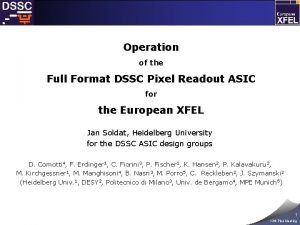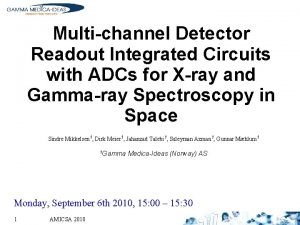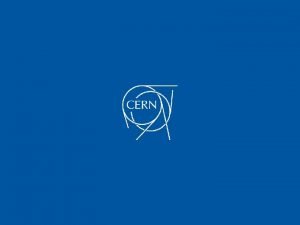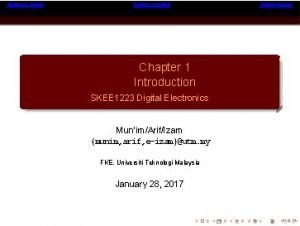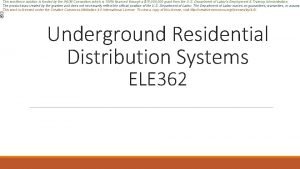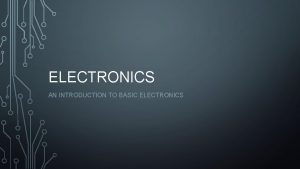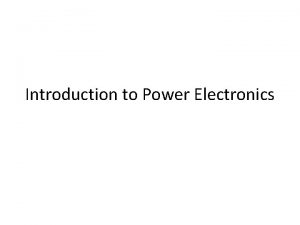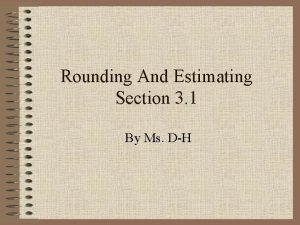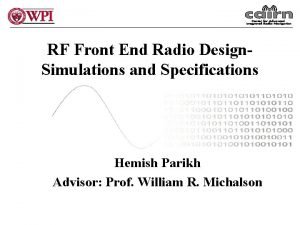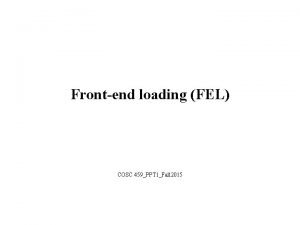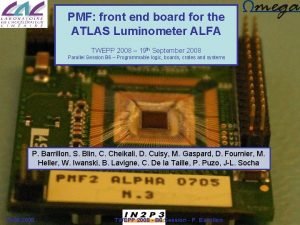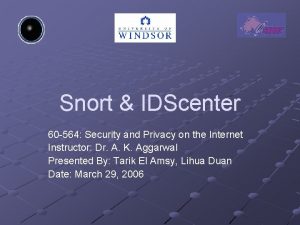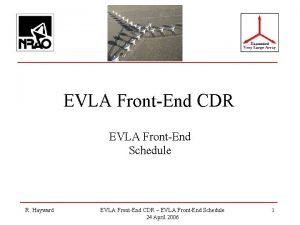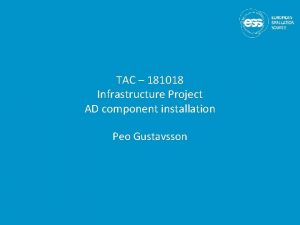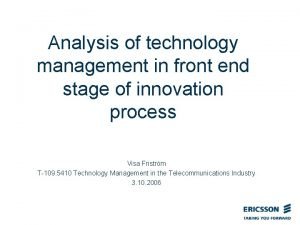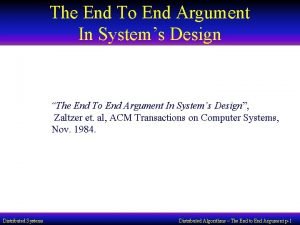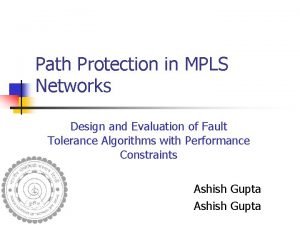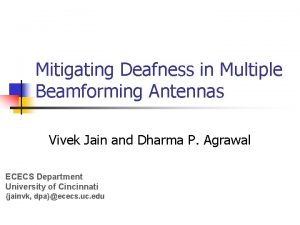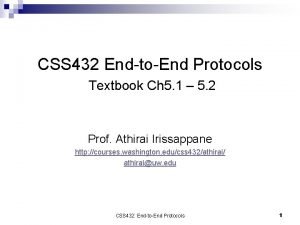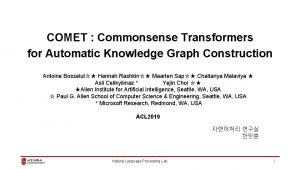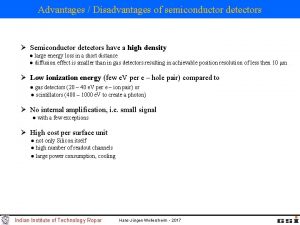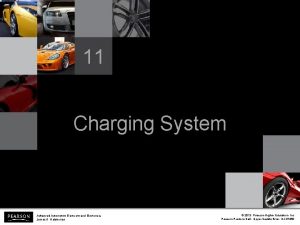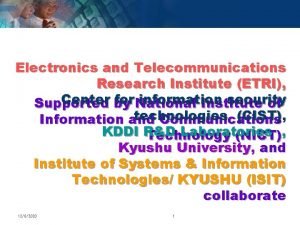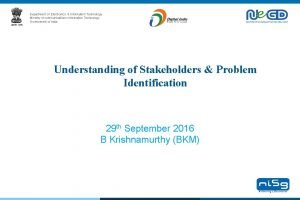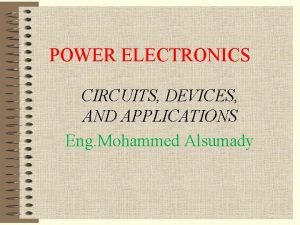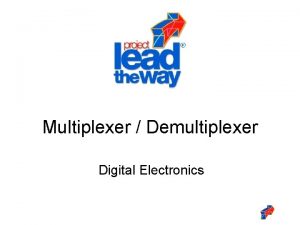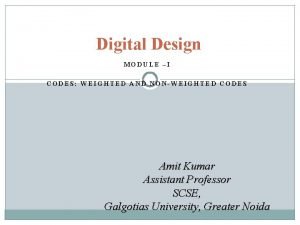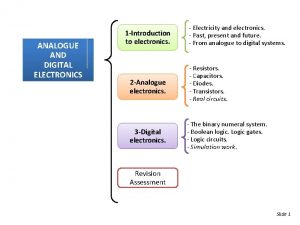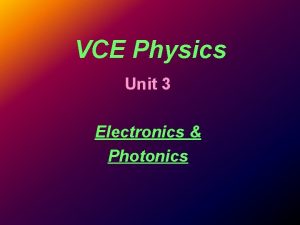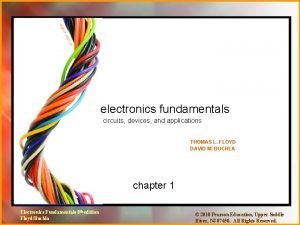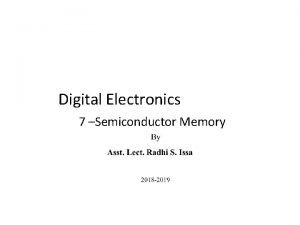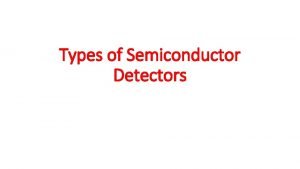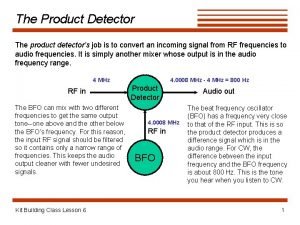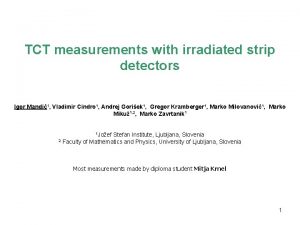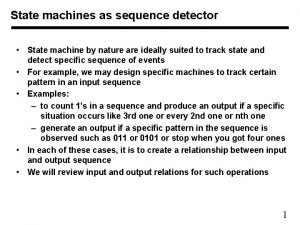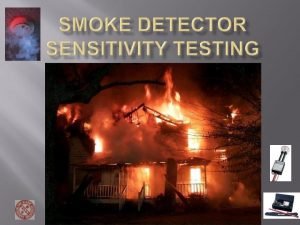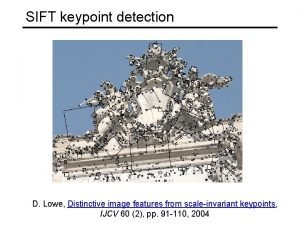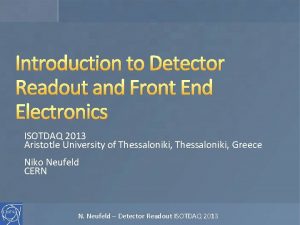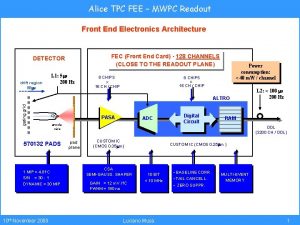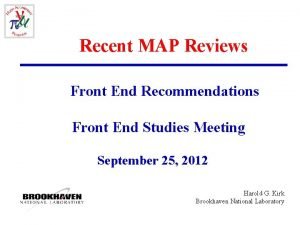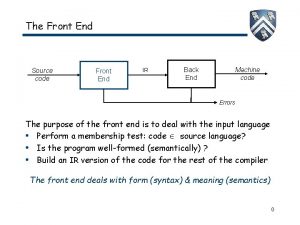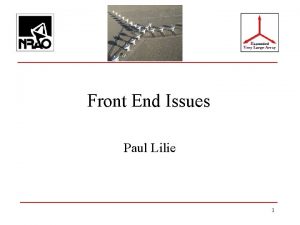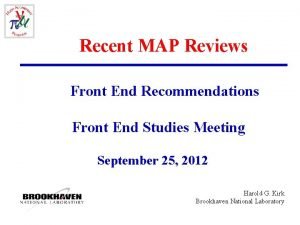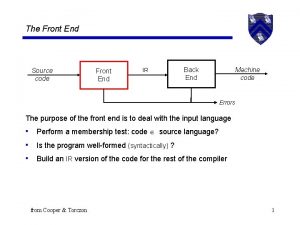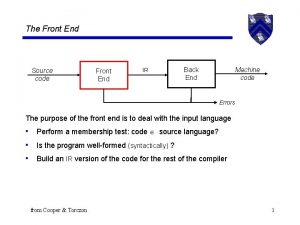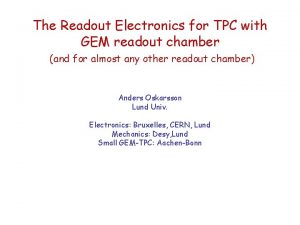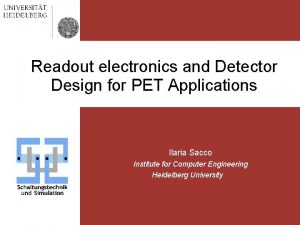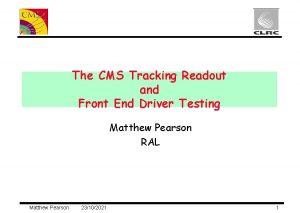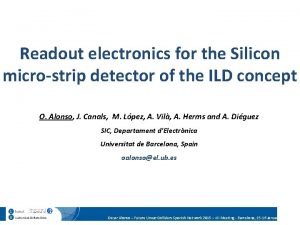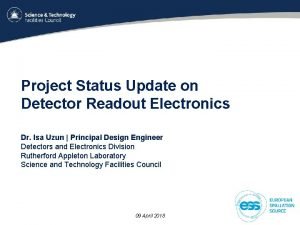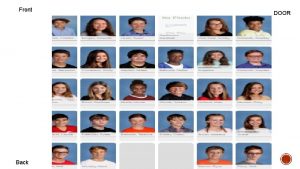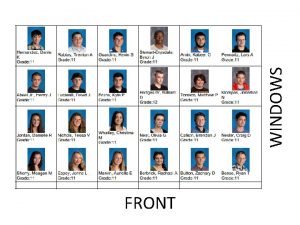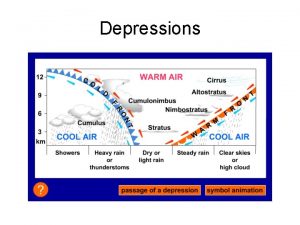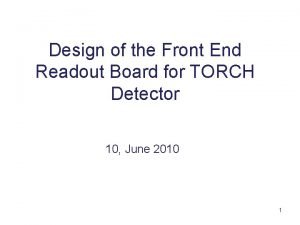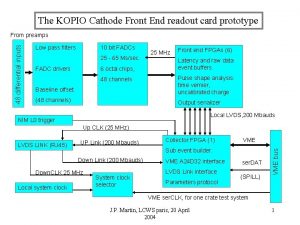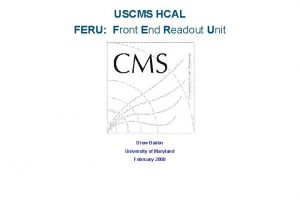Introduction to Detector Readout and Front End Electronics




















































- Slides: 52

Introduction to Detector Readout and Front End Electronics ISOTDAQ 2015 CBPF, Rio de Janeiro Rainer Schwemmer CERN R. Schwemmer – Detector Readout ISOTDAQ 2015

Thanks… …to all my colleagues at CERN and elsewhere who taught me what I know R. Schwemmer – Detector Readout ISOTDAQ 2015 2

Initial questions When working on the DAQ why should we care about Detector Readout and Frontend Electronics? It is important to understand our colleagues The Frontend electronics is the source of the data When designing an experiment the overall cost and complexity will be a compromise between what you can do in your electronics and what you must do in your data acquisition R. Schwemmer – Detector Readout ISOTDAQ 2015 3

Once upon a time… from Wikipedia R. Schwemmer – Detector Readout ISOTDAQ 2015 4

R. Schwemmer – Detector Readout ISOTDAQ 2015 5

How do we “read” ATLAS data? Electromagnetic Calorimetry Muon chambers Beam pipe Tracking (in solenoid field) Hadronic Calorimetry R. Schwemmer – Detector Readout ISOTDAQ 2015 6

Tracking Separate tracks by charge and momentum Position measurement layer by layer Inner layers: silicon pixel and strips presence of hit determines position Outer layers: “straw” drift chambers need time of hit to determine position R. Schwemmer – Detector Readout ISOTDAQ 2015 7

Calorimetry Particles generate showers in calorimeters Electromagnetic Calorimeter (yellow): Absorbs and measures the energies of all electrons, photons Hadronic Calorimeter (green): Absorbs and measures the energies of hadrons, including protons and neutrons, pions and kaons amplitude measurement required to find deposited charge position information provided by segmentation of detector R. Schwemmer – Detector Readout ISOTDAQ 2015 8

Muon System Electrons formed along the track drift towards the central wire. Track The first electron to reach the highfield region initiates the avalanche, which is used to derive the timing pulse. Δt ATLAS Muon drift chambers have a radius of 3 cm and are between 1 and 6 m long Since the initiation of the avalanche is delayed by the transit time of the charge from the track to the wire, the detection time of the avalanche can be used to determine the radial position(*) need fast timing electronics (*) Clearly this needs some start of time t=0 (e. g. the beam-crossing) R. Schwemmer – Detector Readout ISOTDAQ 2015 9

Many different detectors – very similar goals Although these various detector systems look very different, at the end it comes down to this: Sensors (“detector-elements”) must determine 1. presence of a signal and/or 2. magnitude of the signal created and/or 3. time of arrival of the signal Some measurements depend on sensitivity, i. e. detection threshold, e. g. : silicon tracker, to detect presence of a particle in a given electrode Others seek to determine a signal very accurately, i. e. resolution, e. g. : calorimeter – magnitude of absorbed energy; muon chambers – time measurement yields position R. Schwemmer – Detector Readout ISOTDAQ 2015 10

The signal S is usually a small current pulse varying in duration (from ~ 100 ps for a Si sensor to O(10) μs for inorganic scintillators) There are many sources of signals. Magnitude of signal depends on deposited signal (energy / charge) and excitation energy Signal Physical effect Excitation energy Electrical pulse (direct) Ionization 30 e. V for gases 1 - 10 e. V for semiconductors Scintillation light Excitation of optical states 20 – 500 e. V Temperature Excitation of lattice vibrations me. V R. Schwemmer – Detector Readout ISOTDAQ 2015 11

The “front-end” electronics` Front-end electronics is the electronics directly connected to the detector (sensitive element) Its purpose is to acquire an electrical signal from the detector tailor the response of the system to optimize the minimum detectable signal energy measurement (charge deposit) event rate time of arrival in-sensitivty to sensor pulse shape digitize the signal and store it for further treatment incident radiation Detector detector Amplifier pre-amplifier Shaping shaping digitization DSP Buffering buffering triggering Triggering multiplexing Multiplexing etc. ETC. R. Schwemmer – Detector Readout ISOTDAQ 2015 DAQ Interface 12

The read-out chain Detector / Sensor Amplifier Filter Shaper clock Range compression Sampling Digital filter Zero suppression Buffer Feature extraction Buffer Format & Readout to Data Acquisition System R. Schwemmer – Detector Readout ISOTDAQ 2015 13

Acquiring the signal Detector / Sensor Need to match to the Amplifier specific detector Filter Fight noise, radiation, Shaper consume (ideally) no Range compression power, be weightless, zeroconfiguration etc… In practice achieved using ASICs made by and for HEP Low level front-end design experiments Ozgur COBANOGLU R. Schwemmer – Detector Readout ISOTDAQ 2015 14

After the black analogue magic As usual ( )what you do depends on many factors: Number of channels and channel density Collision rate and channel occupancies Triggering: levels, latencies, rates Available technology and cost What you can/want to do in custom made electronics and what you do in standard computers (computer farms) Radiation levels Power consumption and related cooling Location of digitization Given detector technology R. Schwemmer – Detector Readout ISOTDAQ 2015 15

The read-out chain: sampling Detector / Sensor Amplifier Filter Shaper clock Range compression Sampling Digital filter Zero suppression Buffer Feature extraction Buffer Format & Readout to Data Acquisition System R. Schwemmer – Detector Readout ISOTDAQ 2015 16

Single integrator Simple (only one sample per channel) Slow rate (and high precision) experiments Long dead time Nuclear physics Not appropriate for HEP ADC 1. 2. 3. DAQ Collect charge from event Convert with ADC Send data to DAQ R. Schwemmer – Detector Readout ISOTDAQ 2015 17

Double buffered Use a second integrator while the first is readout and reset Decreases dead time significantly Still for low rates ADC DAQ R. Schwemmer – Detector Readout ISOTDAQ 2015 18

Multiple event buffers Good for experiments with short spills and large spacing between spills (e. g. fixed target experiment at SPS) Fill up event buffers during spill (high rate) Readout between spills (low rate) ADC can possibly be shared across channels Buffering can also be done digitally (in RAM) Channel mux. Shaping ADC R. Schwemmer – Detector Readout ISOTDAQ 2015 DAQ 19

Constantly Sampled Readout Needed for high rate experiments with signal pileup Shapers and not switched integrators Allows digital signal processing in its traditional form (constantly sampled data stream) Output rate may be far to high for what following DAQ system can handle Sampling clock Shaping ADC DSP DAQ (zero-sup. ) With local zero-suppression this is suitable for future high rate experiments (LHC, CLIC, FAIR) R. Schwemmer – Detector Readout ISOTDAQ 2015 20

Excursion: zero-suppression Why spend bandwidth sending data that is zero for the majority of the time? Perform zero-suppression and only send data with non-zero content Identify the data with a channel number and/or a time-stamp We do not want to loose information of interest so this must be done with great care taking into account pedestals, baseline variations, common mode, noise, etc. Not worth it for occupancies above ~10% Alternative: data compression Huffman encoding and alike (slow, power-intensive) R. Schwemmer – Detector Readout ISOTDAQ 2015 21

TANSTAFL (There Aint No Such Thing As A Free Lunch) Data rates fluctuate all the time and we have to fit this into links with a given bandwidth It is difficult to define a priori what to consider a zero channel Not any more event synchronous Complicated buffer handling (overflows) Before an experiment is built and running it is very difficult to give reliable estimates of data rates needed ( background, new physics, etc. ) “They” will always want to read it out non-zero suppressed R. Schwemmer – Detector Readout ISOTDAQ 2015 22

Trigger (Sneak Preview) SPOILER ALERT R. Schwemmer – Detector Readout ISOTDAQ 2015

What is a trigger? An open-source 3 D rally game? An important part of a Beretta? The most famous horse in movie history? R. Schwemmer – Detector Readout ISOTDAQ 2015 24

What is a trigger? Wikipedia: “A trigger is a system that uses simple criteria to rapidly decide which events in a particle detector to keep when only a small fraction of the total can be recorded. “ Simple Rapid Selective When only a small fraction can be recorded R. Schwemmer – Detector Readout ISOTDAQ 2015 25

Trivial DAQ External View sensor Physical View sensor ADC Card CPU disk Logical View ADC Processing storage R. Schwemmer – Detector Readout ISOTDAQ 2015 26

Trivial DAQ with a real trigger Sensor Trigger Delay Discriminator Start ADC Processing Interrupt storage What if a trigger is produced when the ADC or processing is busy? R. Schwemmer – Detector Readout ISOTDAQ 2015 27

Trigger rate control Trigger rate determined by physics parameters used in trigger system: 1 k. Hz – 1 MHz for LHC experiments The lower rate after the trigger allows sharing resources across channels (e. g. ADC and readout links) Triggers will be of random nature i. e. follow a Poisson distribution a burst of triggers can occur within a short time window so some kind of rate control/spacing is needed Minimum spacing between trigger accepts dead -time Maximum number of triggers within a given time window Derandomizer buffers needed in front-ends to handle this Size and readout speed of this determines effective trigger rate R. Schwemmer – Detector Readout ISOTDAQ 2015 28

Trigger for LHC No ((currently) affordable) DAQ system could read out O(107) channels at 40 MHz 400 TBit/s to read out – even assuming binary channels! What’s worse: most of these millions of events per second are totally uninteresting: one Higgs event every 0. 02 seconds A first level trigger (Level-1, L 1) must somehow* select the more interesting events and tell us which ones to deal with any further Black magic happening here (*) See any lecture on LHC trigger systems R. Schwemmer – Detector Readout ISOTDAQ 2015 29

Distributing the Trigger Assuming now that a Local level-1 trigger magic box tells for each Global Trigger 1 Primitive e, g, jets, µ bunch crossing (clock-tick) ≈ 2 -3 µs yes or no latency loop This decision has to be brought for each crossing to all the detector frontend electronics elements so that they can send of Front-End Digitizer Trigger their data or discard it Primitive Pipeline delay Use the same Timing and Generator ( ≈ 3 µs) Trigger Control (TTC) system as for the clock Accept/Reject LV-1 distribution R. Schwemmer – Detector Readout ISOTDAQ 2015 30

Multilevel triggering First level triggering. Hardwired trigger system to make trigger decision with short latency. Constant latency buffers in the front-ends Second level triggering in DAQ interface Processor based (standard CPU’s or dedicated custom/DSP/FPGA processing) FIFO buffers with each event getting accept/reject in sequential order Circular buffer using event ID to extracted accepted events Non accepted events stays and gets overwritten by new events High level triggering in the DAQ systems made with farms of CPU’s: hundreds – thousands. (separate lectures on this) DAQ interface Data formatting MUX DAQ Front-end Zerosuppression Trigger L 2 Trigger L 1 R. Schwemmer – Detector Readout ISOTDAQ 2015 31

Global clock Trigger Data buffering during trigger Derandomizer buffer But there are other problems related to this: spill over, saturation of detector, etc. R. Schwemmer – Detector Readout ISOTDAQ 2015 Zerosuppression Data formatting No problems if occupancy of detectors or noise higher than expected DAQ Price of links determine if one can afford this MUX Off-detector All channels are doing the same “thing” at the same time Synchronous to a global clock (bunch crossing clock) Data-rate on each link is identical and depends only on trigger -rate On-detector buffers (de-randomizers) are of same size and their occupancy (“how full they are”) depends only on the trigger-rate Lots of bandwidth wasted for zero’s On-detector Synchronous Readout 32

Time Alignment R. Schwemmer – Detector Readout ISOTDAQ 2015 33

Distributing Synchronous Signals @ the LHC An event is a snapshot of the values of all detector front-end electronics elements, which have their value caused by the same collision A common clock signal must be provided to all detector elements Plus: Trigger decision Bunch cross ID Since c is constant, the detectors are large and the electronics are fast, the detector elements must be carefully time-aligned Common system for all LHC experiments TTC based on radiation-hard opto-electronics R. Schwemmer – Detector Readout ISOTDAQ 2015 34

Synchronicity at the LHC N (channels) ~ O(107); Interactions every 25 ns need huge number of connections Need to synchronize detector elements to (better than) 25 ns In some cases: detector signal/time of flight > 25 ns integrate more than one bunch crossing's worth of information need to identify bunch crossing. . . It's On-Line (cannot go back and recover events) need to monitor selection – need very good control over all conditions R. Schwemmer – Detector Readout ISOTDAQ 2015 35

Asynchronous Readout Remove zeros on the detector itself Lower average bandwidth needed for readout links Especially interesting for low occupancy detectors Each channel “lives a life of its own” with unpredictable buffer occupancies and data is sent whenever ready (asynchronous) In case of buffer-overflow a truncation policy is needed BIAS!! Detectors themselves do not have 100% detection efficiency either. Requires sufficiently large local buffers to assure that data is not lost too often (Channel occupancies can be quite non uniform across a detector with same front-end electronics) MUX DAQ Data formatting Zerosuppression R. Schwemmer – Detector Readout ISOTDAQ 2015 Derandomizer buffer 36

Asynchronous Readout - continued DAQ must be able to handle this (buffering!) Async. readout of detectors in LHC: ATLAS and CMS muon drift tube detectors, ATLAS and CMS pixel detectors, ATLAS SCT, several ALICE detectors with a relatively low trigger rate (few k. Hz). On-detector Off-detector MUX DAQ Data formatting Zerosuppression Trigger R. Schwemmer – Detector Readout ISOTDAQ 2015 37

The Read Out Chain Detector / Sensor Amplifier Filter Shaper clock Range compression Sampling Digital filter Zero suppression Buffer Feature extraction Buffer Format & Readout to Data Acquisition System R. Schwemmer – Detector Readout ISOTDAQ 2015 38

To the DAQ: The Readout Link Large amount of data to bring out of detector Large quantity: ~ 100 k links in large experiments (cost!) High speed: Gbits/s Point to point unidirectional Transmitter side has specific constraints Radiation Magnetic fields Power/cooling Minimum size and mass Must collect data from one or several front-end chips Receiver side can be commercially available module/components (use of standard link protocols whenever possible, e. g. 64/66 bit encoding like in Ethernet) R. Schwemmer – Detector Readout ISOTDAQ 2015 39

Digital optical links High speed: 1 Ghz – 10 GHz – 40 GHz Extensively used in telecommunications (expensive) and in computing (“cheap”) Encoding Inclusion of clock for receiver PLL’s DC balanced Special synchronization characters Error detection and or correction Reliability and error rates strongly depending on received optical power and timing jitter Multiple serializers and deserializers directly available in modern high end FPGA’s. Used everywhere in the LHC experiments, will also be standard for future upgrades (Versatile Link / GBT and similar) R. Schwemmer – Detector Readout ISOTDAQ 2015 40

Readout Links of LHC Experiments Flow Control DDL Optical 200 MB/s ≈ 400 links Full duplex: Controls FE (commands, Pedestals, Calibration data) Receiver card interfaces to PC SLINK Optical: 160 MB/s ≈ 1600 Links Receiver card interfaces to PC. yes SLINK 64 LVDS: 200 MB/s (max. 15 m) ≈ 500 links Peak throughput 400 MB/s to absorb fluctuations Receiver card interfaces to commercial NIC yes Glink (GOL) Optical 200 MB/s ≈ 4000 links Receiver card interfaces to custom-built Ethernet NIC (4 x 1 Gbit/s over copper) R. Schwemmer – Detector Readout ISOTDAQ 2015 yes (no) 41

DAQ interfaces / Readout Boards Front-end data reception Receive optical links from multiple front-ends: 24 - 96 Located outside radiation Event checking Verify that data received is correct Verify correct synchronization of front-ends Extended digital signal processing to extract information of interest and minimize data volume Event merging/building Build consistent data structures from the individual data sources so it can be efficiently sent to DAQ CPU farm and processed efficiently without wasting time reformatting data on CPU. Requires significant data buffering R. Schwemmer – Detector Readout ISOTDAQ 2015 42

DAQ interfaces / Readout Boards 2 High level of programmability needed Send data to CPU farm at a rate that can be correctly handled by farm 1 Gbits/s Ethernet (next is 100 Gbits/s) In house link with PCI interface: S-link Requires a lot of fast digital processing and data buffering: FPGA’s, DSP’s, embedded CPU Readout Link Use of ASIC’s not justified Complicated modules that are only half PCI interface made when the hardware is there: card FPGA firmware (from HDL), DSP code, on-board CPU software, etc. Readout PC PC provides standardised interface and buffering! R. Schwemmer – Detector Readout ISOTDAQ 2015 43

The Undiscovered Country …(“the future of detector readout”) R. Schwemmer – Detector Readout ISOTDAQ 2015 44

Compressed Baryonic Matter (CBM) Heavy Ion experiment planned at future FAIR facility at GSI (Darmstadt) Timescale: ~2018 Detector Elements • Si for Tracking • RICH and TRDs for Particle identification • RPCs for To. F measurement • ECal for Electromagnetic Calorimetry Average Multiplicities: 160 p 400 π+ 44 K+ 13 K 800 g 1817 total at 10 MHz R. Schwemmer – Detector Readout ISOTDAQ 2015 45

High Multiplicities Quite Messy Events… (cf. Alice) Hardware triggering problematic Complex Reconstruction ‘Continuous’ beam Trigger-Free Readout ‘Continuous’ beam Self-Triggered channels with precise time-stamps Correlation and association later in CPU farm R. Schwemmer – Detector Readout ISOTDAQ 2015 46

CBM Characteristics/Challenges • Very low-jitter (10 ps) timing distribution network • Data collection network to link detector elements with front-end electronics (link speed O(GB/s)) High-performance (~O(TB/s)) event building switching network connecting O(1000) Data Collectors to O(1000) Filter Nodes R. Schwemmer – Detector Readout ISOTDAQ 2015 47

CBM DAQ Architecture R. Schwemmer – Detector Readout ISOTDAQ 2015 48

LHCb DAQ Architecture for 2019 Readout Supervisor L 0 Hardware Trigger Current HLT 1 Gb Ethernet 1 MHZ Tell 1 Readout Supervisor 40 MHZ Trigger 100 Gb PCIe 1… 40 MHZ Upgrade Interaction HLT++ Tell 40 GBT (4. 8 Gb/s) data rate 3. 2 Gb/s - All data will be readout @ collision rate 40 MHz by all frontend electronics (FEE) a triggerfree read-out! - Zero-suppression will be done in FEEs to reduce the number of the Giga. Bit Transceiver (GBT) links Expected Output BW: 40 Tbit/s R. Schwemmer – Detector Readout ISOTDAQ 2015 49

In conclusion… R. Schwemmer – Detector Readout ISOTDAQ 2015 50

What Do We Need to Read Out a Detector (successfully)? A selection mechanism (“trigger”) Electronic readout of the sensors of the detectors (“front-end electronics”) A system to keep all those things in sync (“clock”) A system to collect the selected data (“DAQ”) A Control System to configure, control and monitor the entire DAQ Time, money, students (lots of them, I mean YOU!) R. Schwemmer – Detector Readout ISOTDAQ 2015 51

Further Reading H. Spieler, “Semiconductor Detector Systems”, Oxford Univ. Press, 2005 A. Sedra, K. Smith, “Microelectronic Circuits”, Oxford Univ. Press, 2009 W. R. Leo, “Techniques for Nuclear and Particle Physics Experiments”, Springer, 1994 O. Cobanoglu “Low-level front-end design”, this school Wikipedia! Conferences IEEE Realtime CHEP TWEPP IEEE NSS-MIC Journals IEEE Transactions on Nuclear Science, in particular the proceedings of the IEEE Realtime conferences R. Schwemmer – Detector Readout ISOTDAQ 2015 52
 Readout device
Readout device Full pixel readout
Full pixel readout Readout integrated circuit
Readout integrated circuit Readout units
Readout units Compiler front end and back end
Compiler front end and back end Explain front end and back end of compiler
Explain front end and back end of compiler Fronts drawing
Fronts drawing Analog vs digital chips
Analog vs digital chips Dead front vs live front transformer
Dead front vs live front transformer Front page of school magazine
Front page of school magazine Introduction to basic electronics
Introduction to basic electronics Introduction to power electronics
Introduction to power electronics Rounding and estimating
Rounding and estimating Front end estimation with decimals
Front end estimation with decimals Vectron
Vectron Front end loading
Front end loading Front end board
Front end board Snort front end
Snort front end Fuzzy front end
Fuzzy front end Cdr
Cdr Front end inspection
Front end inspection Front end stage
Front end stage Pressure-volume loop
Pressure-volume loop End diastolic volume meaning
End diastolic volume meaning End zu end descendorektostomie
End zu end descendorektostomie End-to-end wireframe parsing
End-to-end wireframe parsing End to end argument in system design
End to end argument in system design End to end accounting life cycle tasks
End to end accounting life cycle tasks Protect
Protect End to end delay
End to end delay End to end
End to end Comet nlp
Comet nlp Multiple procurement cycles
Multiple procurement cycles Advantages of semiconductor detector
Advantages of semiconductor detector Setup time and hold time in digital electronics
Setup time and hold time in digital electronics Advanced automotive electricity and electronics
Advanced automotive electricity and electronics Electronics and telecommunications research institute
Electronics and telecommunications research institute Ministry of electronics and information technology
Ministry of electronics and information technology E & it department odisha
E & it department odisha Power electronics circuits devices and applications
Power electronics circuits devices and applications Multiplexer and demultiplexer in digital electronics
Multiplexer and demultiplexer in digital electronics Weighted and non weighted codes with example
Weighted and non weighted codes with example Analogue and digital electronics
Analogue and digital electronics Current divider formula
Current divider formula Electronics fundamentals circuits devices and applications
Electronics fundamentals circuits devices and applications What is memory expansion in digital electronics
What is memory expansion in digital electronics Detector building science olympiad cheat sheet
Detector building science olympiad cheat sheet Diffused junction detector
Diffused junction detector What is a product detector?
What is a product detector? Spaghetti detector
Spaghetti detector Sequence detector examples
Sequence detector examples Walter jaeger smoke detector
Walter jaeger smoke detector Lowe sift
Lowe sift

